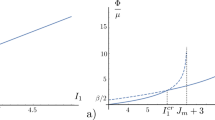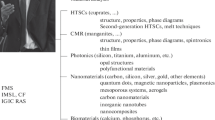We analyze the development of investigations and scientific results in the field of physicochemical mechanics of materials, which plays the role of contemporary scientific direction in materials science. The main stages of development of this direction in the Ukrainian National Academy of Sciences are considered and the role of H. V. Karpenko in the formation and development of this branch of science is described. We also synthesize the most important scientific results, illustrate some their practical applications, and formulate urgent problems of the future investigations.
Similar content being viewed by others
References
P. A. Rehbinder, Materials of the IV Congress of Russian Physicists [in Russian], Moscow (1928); Jubilee Collection of the Academy of Sciences of the USSR to the 30th Anniversary of the Great October Revolution [in Russian], Vol. 1, Izd. Akad. Nauk SSSR, Moscow (1947).
V. I. Likhtman, P. A. Rehbinder, and G. V. Karpenko, Influence of the Surface-Active Media on the Processes of Deformation of Metals [in Russian], Izd. Akad. Nauk SSSR, Moscow (1954).
G. V. Karpenko, Influence of Active Liquid Media on the Endurance of Steel [in Russian], Izd. Akad. Nauk Ukr. SSR, Kiev (1955).
V. V. Panasyuk, “On the most important problems of the research into the physicochemical mechanics of structural materials,” Fiz.-Khim. Mekh. Mater., 9, No. 4, 3–12 (1974).
V. I. Likhtman, E. D. Shchukin, and P. A. Rehbinder, Physicochemical Mechanics of Metals [in Russian], Izd. Akad. Nauk SSSR, Moscow (1962).
H. V. Karpenko and F. P. Yanchyshyn, “On the problem of simultaneous influence of corrosive media and stress concentration on the endurance of steel,” Dop. Akad. Nauk Ukr. SSR, No. 6, 525–528 (1955).
V. V. Panasyuk and S. E. Kovchik, “Effect of the surface-active medium on the surface brittle-fracture energy of the body,” Dokl. Akad. Nauk SSSR, 146, No. 1, 82–85 (1962).
V. V. Panasyuk, L. V. Ratych, and I. N. Dmytrakh, “On some problems of cyclic crack-growth resistance of materials in liquid media,” Fiz.-Khim. Mekh. Mater., 17, No. 6, 42–49 (1982); V. V. Panasyuk, L. V. Ratych, and I. M. Dmytrakh, “Fatigue-crack growth in corrosive environments,” Fatigue Fract. Eng. Mater. Struct., 7, No. 1, 1–11 (1984).
G. V. Karpenko and A. V. Karlashov, “Influence of the absolute sizes of specimens on the adsorption and corrosion fatigue of steel,” Dokl. Akad. Nauk SSSR, 92, No. 3, 603–605 (1953).
R. G. Pogoretskii, K. P. Tabinskii, N. N. Tkachenko, and G. V. Karpenko, “On the problem of inversion of the scale factor under the conditions of corrosion fatigue of steel,” Fiz.-Khim. Mekh. Mater., 2, No. 3, 357–358 (1966); G. V. Karpenko, R. G. Pogoretskii, V. I. Pokhmurskii, et al., A Machine for Fatigue Tests [in Russian], USSR Author’s Certificate No. 356512, MKI G01n3/34, Publ. on 23.10.72, Bull. No. 37.
G. V. Karpenko, K. B. Katsov, I. V. Kokotailo, and V. P. Rudenko, Low-Cycle Fatigue of Steel in Working Media [in Russian], Naukova Dumka, Kiev (1977).
H. V. Karpenko, Corrosion Fatigue of Steel [in Ukrainian], Vyd. Akad. Nauk Ukr. RSR, Kyiv (1959).
H. V. Karpenko and A. I. Yatsyuk, Effect of the Surface Treatment on the Fatigue Strength of Steel in Active Media [in Ukrainian], Vyd. Akad. Nauk Ukr. RSR, Kyiv (1958).
G. V. Karpenko, Strength of Steel in Corrosive Media [in Russian], Mashgiz, Moscow (1963).
G. V. Karpenko and I. I. Vasilenko, Corrosion Cracking of Steels [in Russian], Tekhnika, Kiev (1971).
H. V. Karpenko, On the Physicochemical Mechanics of Metals [in Ukrainian], Naukova Dumka, Kyiv (1973).
V. I. Pokhmurskii, Corrosion-Fatigue Strength of Steels and the Methods for Its Elevation [in Russian], Naukova Dumka, Kiev (1974).
Yu. I. Babei, Physical Foundations of the Pulsed Hardening of Steel and Cast Iron [in Russian], Naukova Dumka, Kiev (1988).
A. N. Tynnyi, Strength and Fracture of Polymers Under the Action of Liquid Media [in Russian], Naukova Dumka, Kiev (1975).
G. V. Karpenko, Influence of the Environment on the Strength and Durability of Metals [in Russian], Naukova Dumka, Kiev (1976).
I. I. Vasilenko and R. K. Melekhov, Corrosion Cracking of Steels [in Russian], Naukova Dumka, Kiev (1977).
R. K. Melekhov, Corrosion Cracking of Titanium and Aluminum Alloys [in Russian], Naukova Dumka, Kiev (1979); R. K. Melekhov, A. I. Radkevich, A. M. Krutsan, and L. M. Karvatskii, “On the sulfide-cracking resistance of domestic structural steels,” Zashch. Met., No. 5, 493–497 (1977).
M. I. Chaevskii and V. F. Shatinskii, Improvement of the Serviceability of Steels in Corrosive Media Under Cyclic Loading [in Russian], Naukova Dumka, Kiev (1970).
V. F. Shatinskii, O. M. Zbozhnaya, and G. G. Maksimovich, Application of Diffusion Coatings in Media of Fusible Metals [in Russian], Naukova Dumka, Kiev (1976).
G. G. Maksimovich, V. F. Shatinskii, and M. S. Goikhman, Diffusion Coatings of Precious Metals [in Russian], Naukova Dumka, Kiev (1978).
V. I. Pokhmurskii, V. B. Dalisov, and V. M. Golubets, Elevation of the Durability of Machine Parts with the Help of Diffusion Coatings [in Russian], Naukova Dumka, Kiev (1980).
Yu. I. Babei and N. G. Soprunyuk, Protection of Steels Against Stress-Corrosion Fracture [in Russian], Naukova Dumka, Kiev (1981).
G. V. Karpenko, Selected Works [in Russian], Vol. 1: Physicochemical Mechanics of Structural Materials, Vol. 2: Serviceability of Structural Materials in Corrosive Media, Naukova Dumka, Kiev (1985).
G. G. Maksimovich, V. F. Shatinskii, E. M. Lyutyi, et al., High-Temperature Serviceability of Refractory Metals and Alloys in Corrosive Media [in Russian], Naukova Dumka, Kiev (1982).
G. G. Maksimovich, V. F. Shatinskii, and V. I. Kopylov, Physicochemical Processes in the Course of Plasma Spraying and Destruction of Materials with Coatings [in Russian], Naukova Dumka, Kiev (1983).
G. G. Maksimovich, V. N. Fedirko, Ya. I. Spektor, and A. T. Pichugin, Thermal Treatment of Titanium and Aluminum Alloys in Vacuum and Inert Media [in Russian], Naukova Dumka, Kiev (1987).
V. F. Shatinskii and A. I. Nesterenko, Protective Diffusion Coatings [in Russian], Naukova Dumka, Kiev (1988).
V. I. Pokhmurs’kyi, R. K. Melekhov, H. M. Krutsan, and V. H. Zdanovs’kyi, Stress Corrosion Fracture of Welded Structures [in Ukrainian], Naukova Dumka, Kyiv (1995).
V. I. Pokhmurskii, Corrosion Fatigue of Metals [in Russian], Metallurgiya, Moscow (1985).
L. N. Petrov and N. G. Soprunyuk, Stress-Corrosion Fracture of Metals [in Russian], Naukova Dumka, Kiev (1991).
H. V. Karpenko, Influence of Hydrogen on the Mechanical Properties of Steel [in Ukrainian], Vyd. Akad. Nauk Ukr. RSR, Kyiv (1960).
G. V. Karpenko and R. I. Kripyakevich, Influence of Hydrogen on the Properties of Steel [in Russian], Metallurgizdat, Moscow (1962).
G. V. Karpenko, A. K. Litvin, and V. I. Tkachev, “On the mechanism of hydrogen brittleness of metals,” Fiz.-Khim. Mekh. Mater., 8, No. 4, 6–11 (1973); G. V. Karpenko, K. B. Katsov, A. K. Litvin, and V. I. Tkachev, A Procedure of Treatment of Metals [in Russian], USSR Author’s Certificate, No. 654,062, Publ. on 05.07.1977, Bull. No. 25.
A. K. Litvin and V. I. Tkachev, “Phenomenon of facilitation of the deformation and fracture of metals in the presence of hydrogen,” Fiz.-Khim. Mekh. Mater., No. 2, 27–34 (1976).
G. V. Karpenko, K. B. Katsov, A. K. Litvin, and V. I. Tkachev, A Method for Decreasing the Friction Coefficient of Metals [in Russian], USSR Author’s Certificate No. 609,021, Publ. on 30.05.1978, Bull. No. 20.
V. N. Zhitomirskii, T. D. Voznyi, and V. I. Tkachev, “Influence of hydrogen on the deformation of the surface layers of metals,” Fiz.-Khim. Mekh. Mater., 17, No. 3, 115–116 (1982).
V. I. Pokhmurskii, M. M. Shved, and N. Ya. Yaremchenko, Influence of Hydrogen on the Processes of Deformation and Fracture of Iron and Steel [in Russian], Naukova Dumka, Kiev (1977); M. M. Shved, Changes in the Operating Properties of Iron and Steel Under the Influence of Hydrogen [in Russian], Naukova Dumka, Kiev (1985).
V. I. Pokhmurskii and V. V. Fedorov, “Some specific features of the influence of hydrogen on the magnetic and structural transformations in transition metals and alloys based on these metals,” Fiz.-Khim. Mekh. Mater., 16, No. 1, 3–11 (1981).
V. I. Pokhmurskii, I. I. Sidorak, R. G. Parkheta, et al., Methodical Recommendations on the Evaluation of High-Temperature Hydrogen Permeability of Metals [in Russian], Preprint No. 117, Physicomechanical Institute, Academy of Sciences of the Ukr. SSR, Lviv (1983); OST 92–4949–84: Branch Standard. Metals. Methods for the Evaluation of High-Temperature Hydrogen Permeability [in Russian], Moscow (1984).
V. I. Pokhmurs’kyi, “Investigations of the influence of hydrogen on metals carried out at the Karpenko Physicomechanical Institute,” Fiz.-Khim. Mekh. Mater., 33, No. 4, 25–38 (1997); English translation: Mater. Sci., 33, No. 4, 421–435 (1997).
A. E. Andreikiv, V. V. Panasyuk, and V. S. Kharin, “Theoretical aspects of the kinetics of hydrogen embrittlement of metals,” Fiz.-Khim. Mekh. Mater., No. 3, 3–23 (1978).
V. V. Panasyuk, A. E. Andreikiv, and V. S. Kharin, “A model of crack growth in deformed metals under the action of hydrogen,” Fiz.-Khim. Mekh. Mater., 22, No. 2, 3–17 (1987).
V. V. Panasyuk, A. E. Andreikiv, and O. I. Obukhivskii, “A numerical model of crack growth in metals under the action of hydrogen,” Fiz.-Khim. Mekh. Mater., 19, No. 3, 3–6 (1984).
A. E. Andreikiv and O. M. Goliyan, “Subcritical growth of fatigue cracks in metals under the action of hydrogen,” Fiz.-Khim. Mekh. Mater., 20, No. 4, 5–8 (1985).
A. E. Andreikiv, N. V Lysak, V. R. Skal’skii, et al., “Acoustic-emission monitoring of hydrogen cracking in metals and alloys,” Fiz.-Khim. Mekh. Mater., 28, No. 4, 63–69 (1992); English translation: Soviet Mater. Sci., 28, No. 4, 378–382 (1992).
A. E. Andreikiv and O. V. Hembara, Fracture Mechanics and Durability of Metallic Materials in Hydrogen-Containing Media [in Ukrainian], Naukova Dumka, Kyiv (2008).
V. V. Panasyuk, O. Ye. Andrejkiv, O. I. Darchuk, and N. V. Kuznyak, “Influence of hydrogen-containing elements on cyclic crack-growth resistance of metals,” in: A. Carpinteri (editor), Handbook of Fatigue Crack Propagation in Metallic Structures, Elsevier, Amsterdam (1994), pp. 1205–1242.
V. Fedorov, I. Bulyk, and V. Panasyuk, “Application of hydrogen as a working medium in manufacturing constant magnets based on alloys with rare-earth metals,” in: Proc. 4th Internat. Conf. “Fracture Mechanics of Materials and Strength of Structures” [in Ukrainian], Karpenko Physicomechanical Institute, Ukrainian National Academy of Sciences, Lviv (2009), pp. 603–608.
Author information
Authors and Affiliations
Corresponding author
Additional information
Translated from Fizyko-Khimichna Mekhanika Materialiv, Vol. 46, No. 2, pp. 9–20, March–April, 2010.
Rights and permissions
About this article
Cite this article
Panasyuk, V.V. Formation of the physicochemical mechanics of materials as a new direction of science. Mater Sci 46, 143–155 (2010). https://doi.org/10.1007/s11003-010-9287-z
Received:
Published:
Issue Date:
DOI: https://doi.org/10.1007/s11003-010-9287-z




